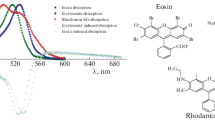Abstract
New data on the influence of osmolytes (NaCl, glycerol) on the destructive effect of ionizing radiation, hyperthermia, microwave radiation and ultrasound were obtained from experiments with bacterial cells. The pattern of manifestation of the osmolyte protective effect is presented. It was found that the protective effect of osmolytes from damaging factors (antagonistic interaction) can be detected only within a certain range of agent “doses.” Inside this range, there is an optimum providing the maximum protection. It was shown that, to provide the highest antagonistic effect with increased intensity of one of the agents, a corresponding change in the intensity of the other agent involved in the interaction is required. It is concluded that, in addition to DNA damage, membrane injury and osmotic homeostasis system may be considered as critical targets in cell destruction after the combined action of various environmental factors.
Similar content being viewed by others
Abbreviations
- SHF:
-
superhigh frequency
- UV:
-
ultraviolet radiation
References
Babicová, A., Havlínová, Z., Hroch, M., Řezáčová, M., Pejchal, J., Vávrová, J., and Chládek, J., In vivo study of radioprotective effect of NO-synthase inhibitors and acetyl-L-carnitine, Physiol. Res., 2013, vol. 62, pp. 701–710.
Bishayee, A, Rao, D.V., and Howell, R.W., Radiation protection by cysteamine against the lethal effects of intracellularly localized Auger electron, α-and β-particle emitting radionuclides, Acta Oncologica, 2000, vol. 39, pp. 713–720.
Bonura, T. and Smith, K.C., The involvement of indirect effects in cell-killing and DNA double-strand breakage in γ-irradiated Escherichia coli K-12, Int. J. Radiat. Biol., 1976, vol. 29, pp. 293–296.
Bychkovskaya, I.B. and Ochinskaya, G.K., Study of the “oxygen effect” at different dose rate of radiation, Radiat. Biol. Radioecol., 1964, vol. 4, no. 1, pp. 63–66.
El’piner, I.E., Biofizika ul’trazvuka (Ultrasound Biophysics), Moscow: Nauka, 1973.
Konev, S.V. and Rudenok, A.N., The permeability and the heat resistance of the yeast cell cytoplasmic membrane, in Biofizika membrane (Membrane Biophysics), Kaunas, 1973, pp. 340–343.
Konev, S.V., Aksentsev, S.A., and Chernitskii, E.A., Kooperativnye perekhody belkov v kletke (Cooperative Transitions of Proteins in Cells), Minsk: Nauka i tekhnika, 1970.
Kuzin, A.M., Molekulyarnaya radiobiologiya kletochnogo yadra (Molecular Radiobiology of the Cell Nucleus), Moscow: Atomizdat, 1973.
Lehninger, A. L., Biochemistry, New York: Worth Publ., 1972.
Lin, P.-S., Kwock, L., and Hefter, K., Protection of heatinduced cytotoxicity by glycerol, J. Cell. Physiol., 1981, vol. 108, pp. 439–443.
Ling, C.C., Spiro, I.J., Mitchell, J., and Stickler, R., The variation of OER with dose rate, Int. J. Radiat. Oncol. Biol. Phys., 1985, vol. 11, pp. 1367–1373.
Maurice, B.B. and Ferraris, J.D., Intracellular organic osmolytes: function and regulation, J. Biol. Chem., 2008, vol. 283, pp. 7309–7313.
Morozov, I.I., Dubovik, B.V., and Petin, V.G., Cellular effects of microwaves of thermal intensity, Radiat. Biol. Radioecol., 1995, vol. 35, no. 1, pp. 47–52.
Ormsby, R.J., Lawrence, M.D., Blyth, B.J., Bexis, K., Bezak, E., Murley, J.S., Grdina, D.J., and Sykes, P.J., Protection from radiation-induced apoptosis by the radioprotector amifostine (WR-2721) is radiation dose dependent, Cell Biol. Toxicol., 2014, vol. 30, pp. 55–66.
Peak, J.G. and Peak, M.J., Protection by glycerol against the biological actions of near-ultraviolet light, Radiat. Res., 1980, vol. 83, pp. 553–558.
Peak, J.G. and Peak, M.J., Similar ultraviolet action spectra for the protection by glycerol of transforming DNA against single-strand breaks and inactivation of biological activity, Radiat. Res., 1984, vol. 97, pp. 570–575.
Petin, V.G. and Anokhin, Yu.N., Synergistic effects of simultaneous action of hyperthermia with physical and chemical agents, Med. Fiz., 2014, vol. 3, no. 63, pp. 57–65.
Petin, V.G. and Kim, J.K., Synergistic Interaction and Cell Responses to Environmental Factors, New York: Nova Publishers, 2014.
Petin, V.G. and Zhurakovskaya, G.P., Some general regularities of manifestation of the greatest synergetic interaction, Radiat. Biol. Radioecol., 2014, vol. 54, no. 6, pp. 589–596.
Petin, V.G., Zhurakovskaya, G.P., and Kalugina, A.V., Microwave dosimetry and lethal effects in laboratory animals, in Radio Frequency Radiation Dosimetry and Its Relationship to the Biological Effects of Electromagnetic Fields, Kluwer Academic Publishers, 2000, pp. 375–382.
Petin, V.G., Zhurakovskaya, G.P., and Komarova, L.N., Radiobiologicheskie osnovy sinergicheskikh vzaimodeystvii v biosfere (Radiobiological Basis of Synergistic Interactions in the Biosphere), Moscow: GEOS, 2012.
Raaphorst, G.P. and Kruuv, J., Effect of tonicity on radiosensitivity of mammalian cells, Int. J. Radiat. Biol., 1976, vol. 29, pp. 493–500.
Raaphorst, G.P. and Kruuv, J., Effect of salt solutions on radiosensitivity of mammalian cells. II. Treatment with hypotonic solutions, Int. J. Radiat. Biol., 1977, vol. 32, pp. 89–101.
Raaphorst, G.P., Frey, H.E., and Kruuv, J., Effect of salt solutions on radiosensitivity of mammalian cell. III. Treatment with hypertonic solutions, Int. J. Radiat. Biol., 1977, vol. 32, pp. 109–126.
Romano, S.L., Raaphorst, G.P., and Dewey, W.C., The effects of various salt and sucrose solutions on the U.V.L. sensitivity of CHO cells, Int. J. Radiat. Biol., 1979, vol. 35, pp. 401–415.
Rozhdestvenskii, L.M., Mekhanizmy radiozaschitnogo effekta i indikatsiya effektivnosti radioprotektorov (Mechanisms of Radioprotective Effect and Indication of the Effectiveness of Radioprotectors), Moscow: Energoatomizdat, 1985.
Voyutskii, S.S., Rastvory vysokomolekulyarnykh soedinenii (The Solutions of Macromolecular Compounds), Moscow: Goshimizdat, 1960.
Author information
Authors and Affiliations
Corresponding author
Additional information
Original Russian Text © I.I. Morozov, V.G. Petin, A.V. Khryachkova, 2017, published in Tsitologiya, 2017, Vol. 59, No. 5, pp. 369–374.
Rights and permissions
About this article
Cite this article
Morozov, I.I., Petin, V.G. & Khryachkova, A.V. The action of osmolytes on the destructive effect of ionizing radiation, hyperthermia, microwave radiation, and ultrasound. Cell Tiss. Biol. 11, 399–404 (2017). https://doi.org/10.1134/S1990519X17050042
Received:
Published:
Issue Date:
DOI: https://doi.org/10.1134/S1990519X17050042




